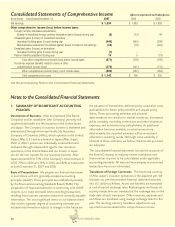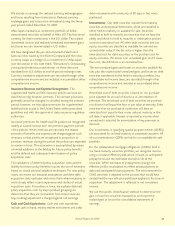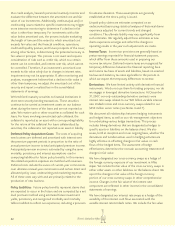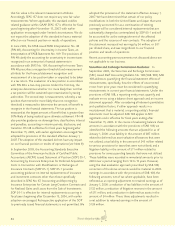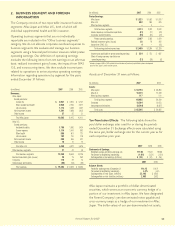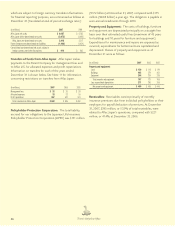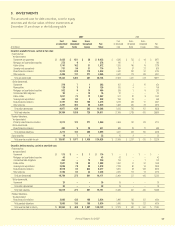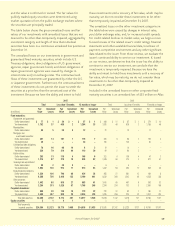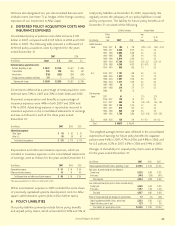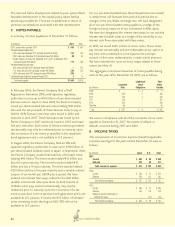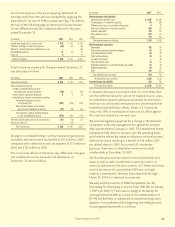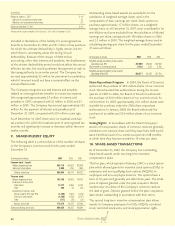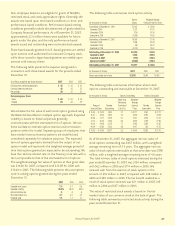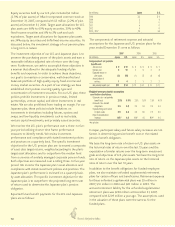Aflac 2007 Annual Report Download - page 64
Download and view the complete annual report
Please find page 64 of the 2007 Aflac annual report below. You can navigate through the pages in the report by either clicking on the pages listed below, or by using the keyword search tool below to find specific information within the annual report.
60 There’s Only One Aflac
Japan’s $123 million (¥14 billion) investment in BAWAG
Capital Finance Jersey II. The decline in fair value of the
security was primarily caused by losses BAWAG incurred from
lending to the failed U.S. brokerage house REFCO and from
derivative speculation in 2000. While BAWAG’s credit rating
has declined from Baa3 to Ba1 (Moody’s), we currently
believe it is probable we will collect all amounts due according
to the contractual terms of the investment. Therefore, it is
expected that our investment would not be settled at a price
less than the amortized cost of the investment. Also included
in the unrealized losses on other corporate fixed-maturity
securities is an unrealized loss of $67 million on Aflac Japan’s
investment of $210 million (¥24 billion) in Tollo Shipping
Company S.A. Our investment is guaranteed by the issuer’s
parent, Compañia Sudamericana de Vapores S.A. (CSAV). The
decline in fair value of the security was primarily caused by
two factors: depressed revenue due to competitive pricing
pressures in the container shipping industry and weaker
operating margins due to sharply increased fuel costs. The
contractual terms of this investment do not permit the issuer
or its parent to settle the security at a price less than the
amortized cost of the investment, and give priority to
repayment of our investment under certain circumstances.
While CSAV’s credit rating has remained at BB+ (S&P), we
currently believe it is probable that we will collect all amounts
due according to the contractual terms of the investment.
Therefore, it is expected that our investment would not be
settled at a price less than the amortized cost of the
investment. Because we have the intent and ability to hold
these investments until recovery of fair value, which may be
the investments’ respective maturities, we do not consider
them to be other-than-temporarily impaired at December 31,
2007.
The net effect on shareholders’ equity of unrealized gains and
losses from investment securities at December 31 was as
follows:
(In millions) 2007 2006
Unrealized gains on securities available for sale $ 941 $ 1,783
Unamortized unrealized gains on securities transferred
to held to maturity 343 378
Deferred income taxes (410) (711)
Shareholders’ equity, unrealized gains
on investment securities $ 874 $ 1,450
Unrealized gains on available-for-sale securities decreased
primarily as a result of a higher interest-rate environment
driven by wider credit spreads globally and also as a result of
foreign currency effects.
We attempt to match the duration of our assets with the
duration of our liabilities. The following table presents the
approximate duration of our yen-denominated assets and
liabilities, along with premiums, as of December 31.
(In years) 2007 2006
Yen-denominated debt securities 13 13
Policy benefits and related expenses to be paid in future years 14 13
Premiums to be received in future years on policies in force 10 10
Currently, when our debt securities mature, the proceeds may
be reinvested at a yield below that of the interest required for
the accretion of policy benefit liabilities on policies issued in
earlier years. However, our strategy of developing and
marketing riders to our older policies has helped offset the
negative investment spread. In spite of the negative
investment spreads, overall profit margins in Aflac Japan’s
aggregate block of business are adequate because of profits
that continue to emerge from changes in mix of business and
favorable mortality, morbidity and expenses.
The contractual maturities of our investments in fixed
maturities at December 31, 2007, were as follows:
Aflac Japan Aflac U.S.
Amortized Fair Amortized Fair
(In millions) Cost Value Cost Value
Available for sale:
Due in one year or less $ 503 $ 508 $ 21 $ 21
Due after one year through five years 4,078 4,608 311 333
Due after five years through 10 years 2,524 2,814 605 652
Due after 10 years 15,056 15,105 5,424 5,600
Mortgage- and asset-backed securities 489 497 279 268
Total fixed maturities
available for sale $ 22,650 $ 23,532 $ 6,640 $ 6,874
Held to maturity:
Due after one year through five years $ 850 $ 904 $ – $ –
Due after five years through 10 years 1,081 1,078 – –
Due after 10 years 14,825 14,146 20 20
Mortgage- and asset-backed securities 43 43 – –
Total fixed maturities
held to maturity $ 16,799 $ 16,171 $ 20 $ 20
The Parent Company has a portfolio of investment-grade
available-for-sale fixed-maturity securities totaling $109 million
at amortized cost and $105 million at fair value, which is not
included in the table above.
Expected maturities may differ from contractual maturities
because some issuers have the right to call or prepay
obligations with or without call or prepayment penalties.
We own subordinated perpetual debenture securities. These
securities are subordinated to other debt obligations of the


